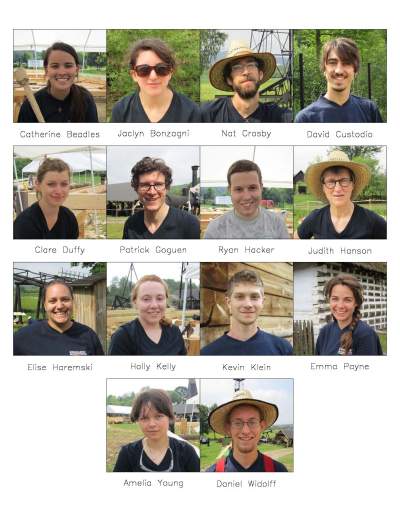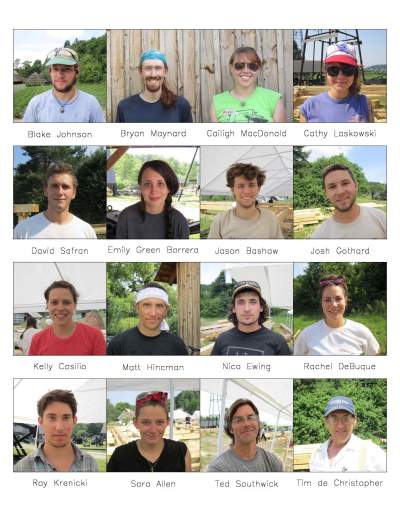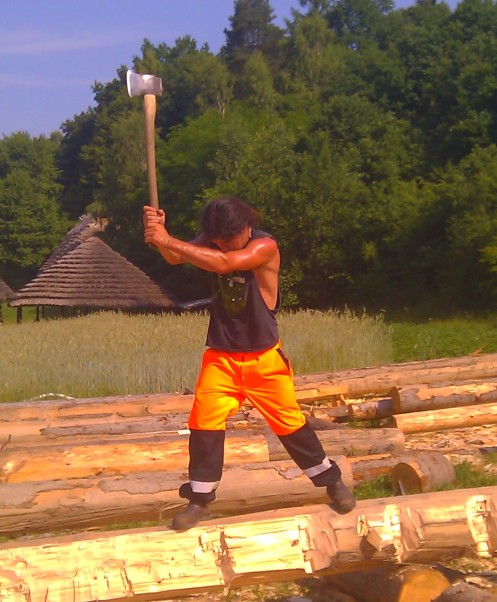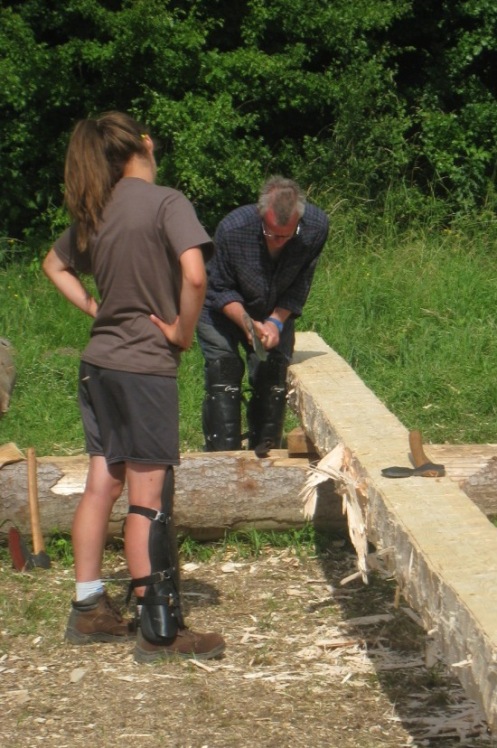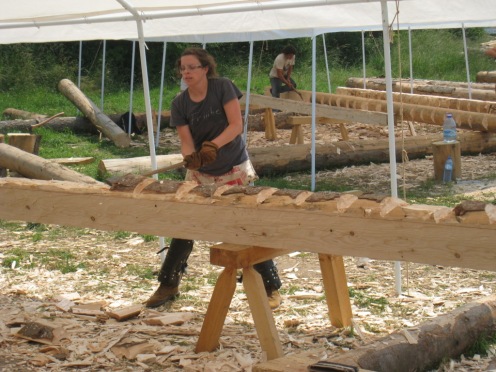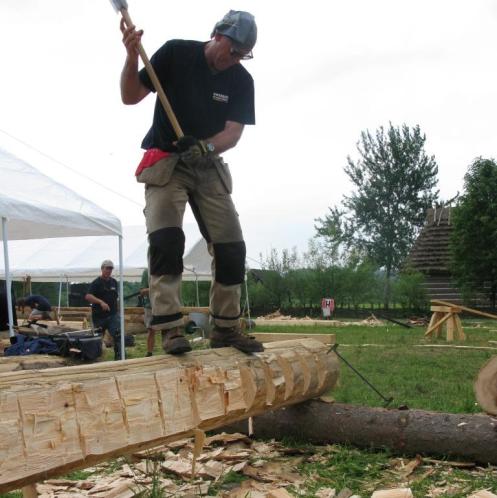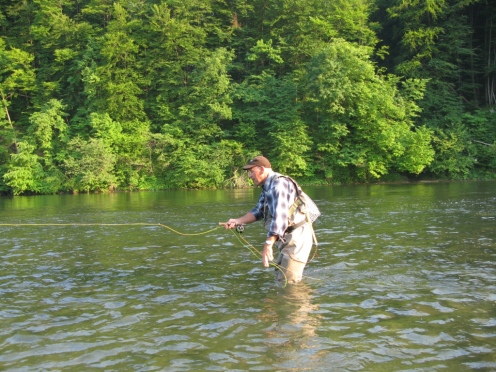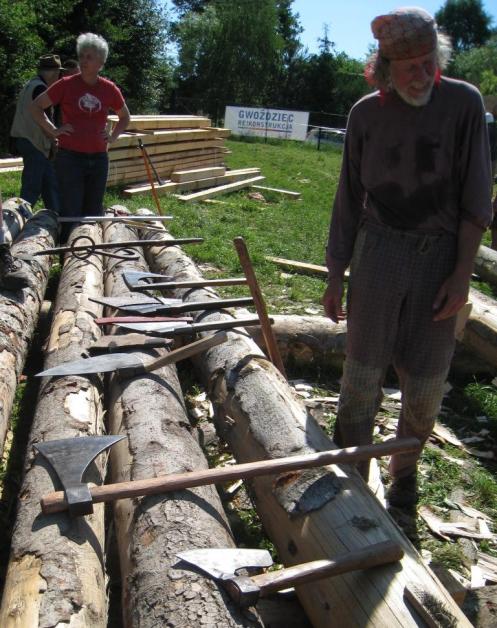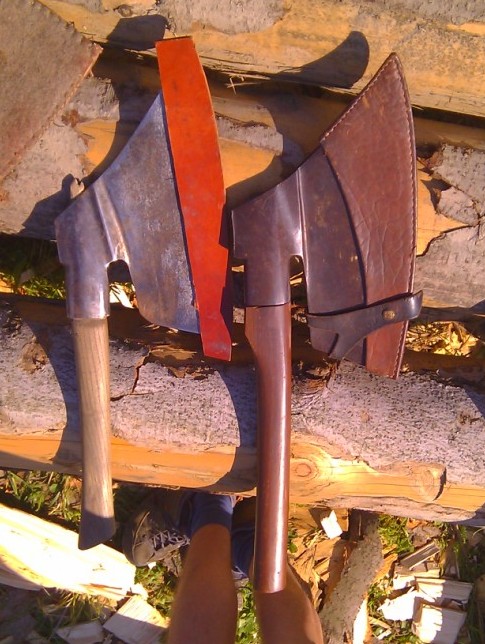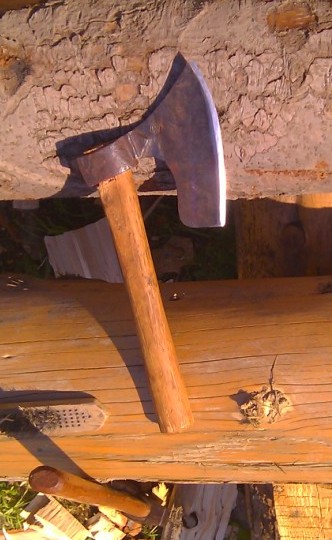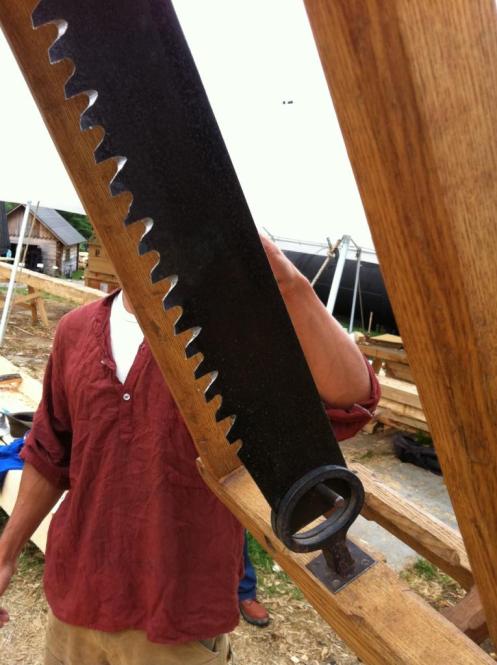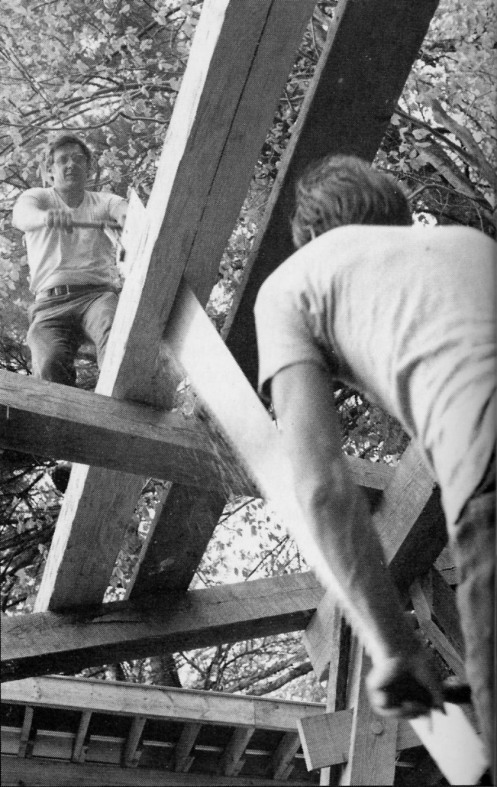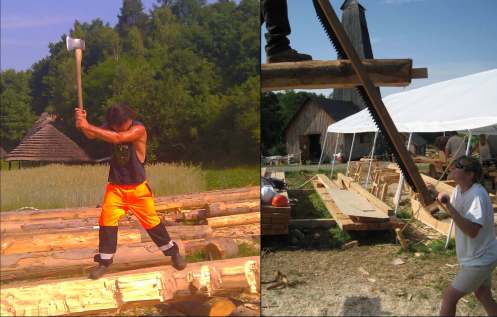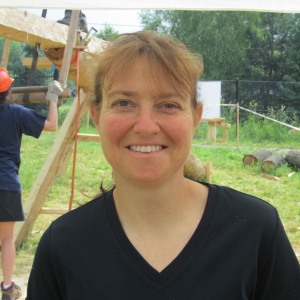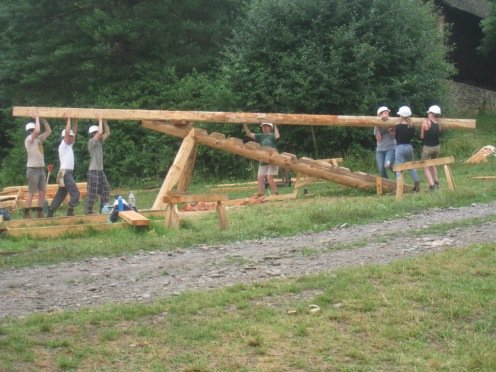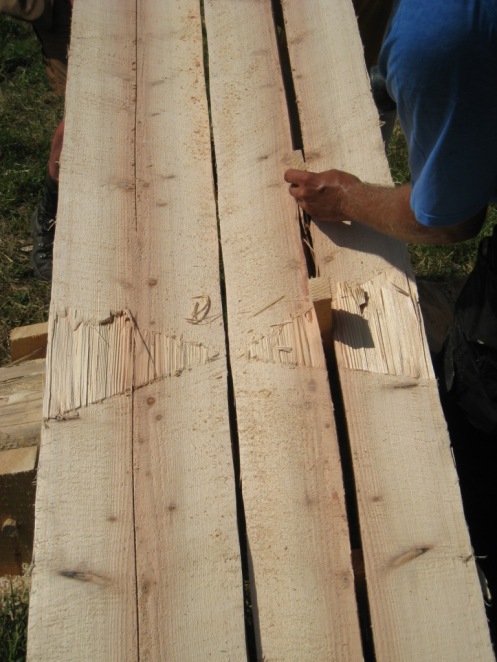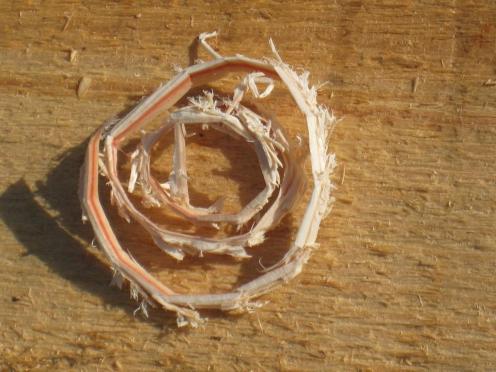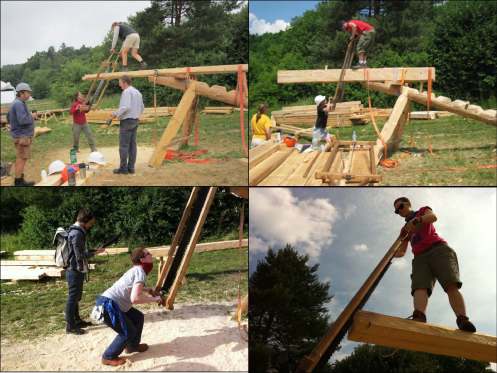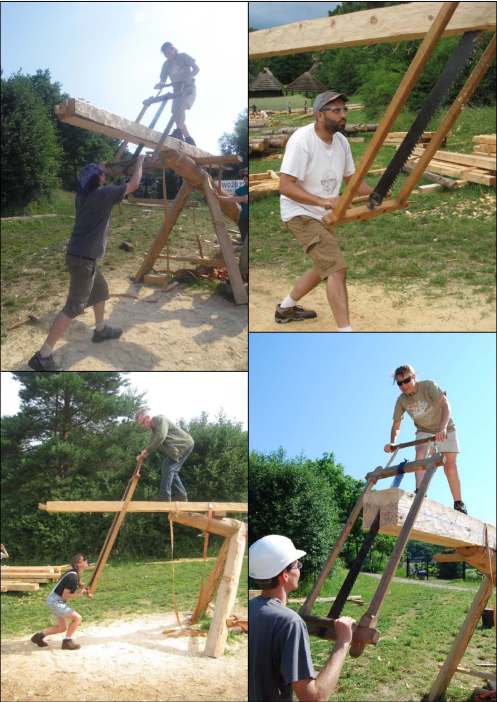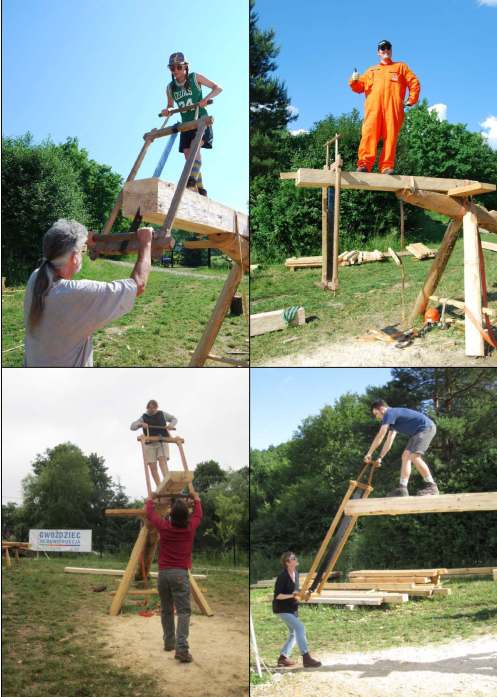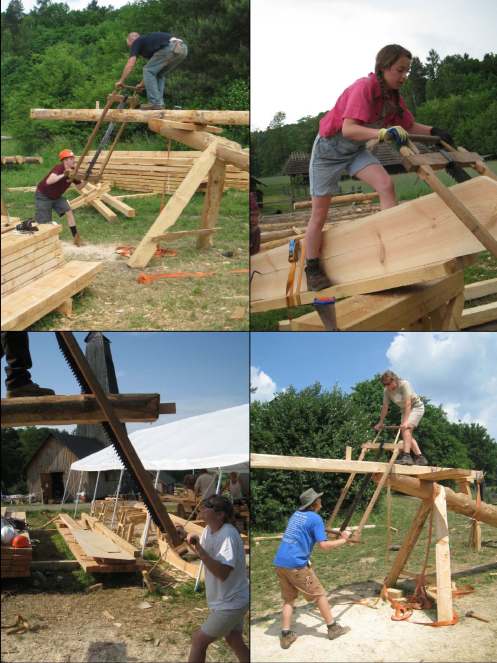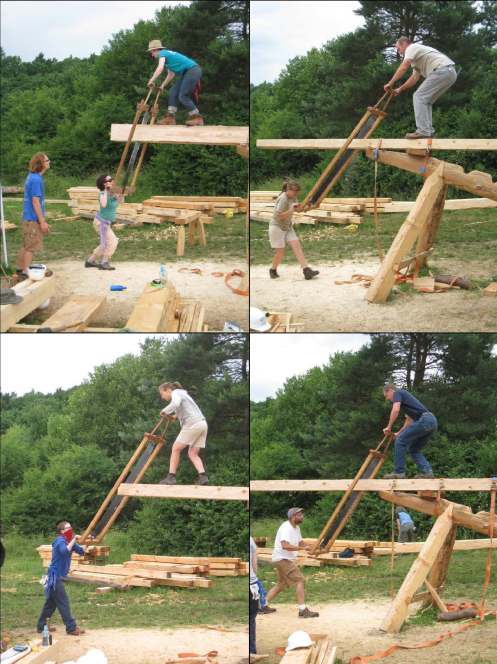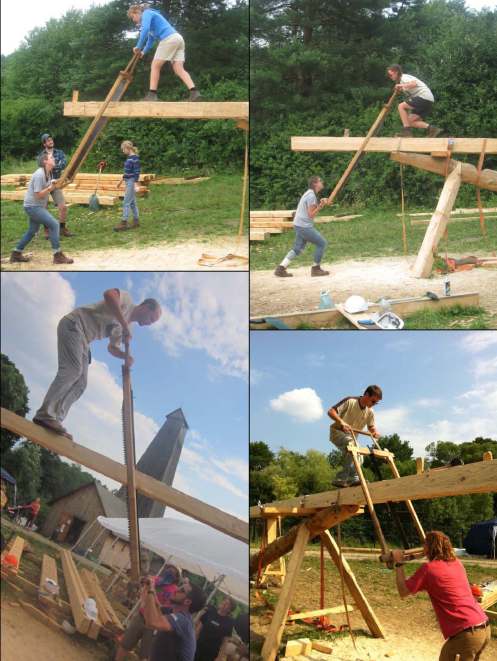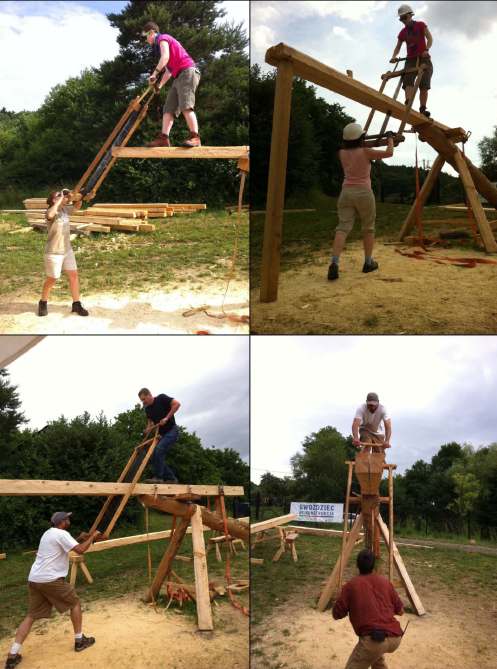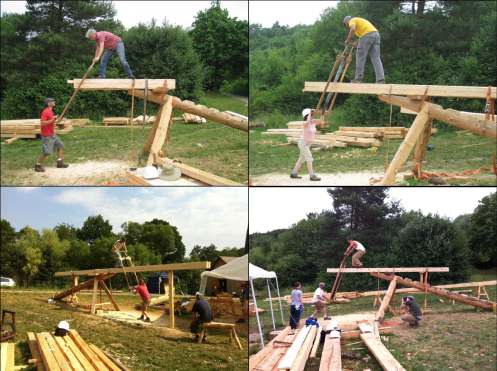With each day our enterprise draws in more people, becomes more complex and varied and sends out more tendrils in every direction. From a few timber framers facing a pile of logs, our population has swelled with students and Polish and international visitors. And beyond timber conversion (hewing and pitsawing), our work has expanded to include stacking log walls, executing all sorts of timber joinery, blacksmithing, a small (very small) foundry for making plumb bobs, plus a not inconsiderable managerial effort to coordinate, food, travel, logistics, guest lecturers, tool and material acquisition, etc. We live, eat, work and play together.
In many ways we function as a village and are bonded together like a tribe. The reality of this cohesion came home to us on Friday when the first group of students cycled back home. Up to that point, we were all about increase, now we had to face our first sense of loss.
Here they are, our friends and comrades, gone from our temporary village back to their other lives. We honor their work and their good comradeship.
The second group of students (and their Handshouse instructors) finished their time at the Skansen in mid-June 2011 and headed out to see a bit more of Poland, then home. We send back newly acquired friends and increasingly competent craftsmen, touched – and we like to think – transformed by the spirit of the synagogue project. We wish them well.
This piece was originally posted July 12.
Tom Haanan is an engineer working for Hilti in Tulsa, Oklahoma, a stalwart Guild member and supporter, and the veteran of multiple Guild projects.
* * *
When the carpenters arrived at the work site on May 24th, there were three immediate assets. A small building that would be our tool room, a work site about the size of a football field and 210 silver fir logs. And our sharp tools that somehow made it through the Transportation Safety Board. The logs covered roughly a sixth of the open expanse. The thought of hewing all the needed timbers loomed large in our psyche. The water closet and source of drinking water were located about 300 meters down the road leading into the Skansen [open air museum].
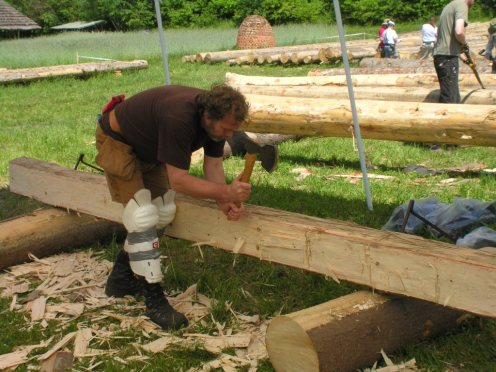
While some of the carpenters started using axes from the get-go, a good portion of the work for the first couple of days focused on building our infrastructure. Setting up three shade tents, building horses and workbenches and constructing shelves inside the tool room to accommodate and organize our equipment.

Although the assembled crew was talented, only Kevin de Silva from Britain and the fine young Danish carpenter, Jacob, were experienced hewers. So the rest of us all entered the hewing house of pain for the first time. Everyone shared in the effort. Ellen Gibson hewed. Leon Buckwalter hewed. The students hewed. Handshouse fixer extraordinaire Kelley Sullivan hewed. Although lead carpenter Mikkel Johansen told us early on that no one should have to hew more than four hours per day, it soon became apparent that this level of effort would not produce enough squared timbers needed to get the rafter, box frame and log wall operations on schedule. So the bulk of the skilled carpenters on site hewed more or less full time for the first couple of weeks. Jacob, Jackson, Adam Z. from Japan, Jordan, Isaac, Isaiah, Mez, Bruce, Mark S., and David from the UK. The yeoman efforts of this group were critical to getting the project up and running.
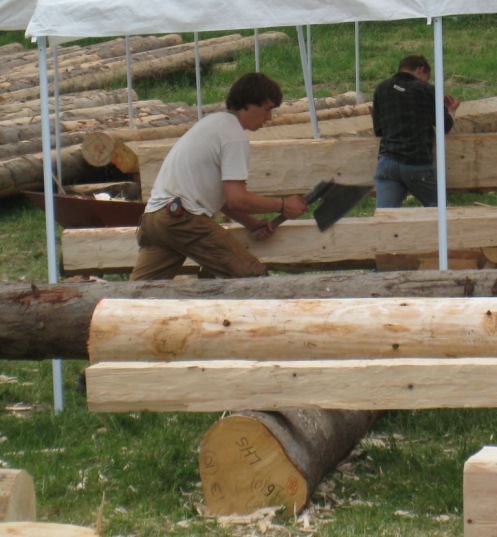
We had to develop technique, endurance and efficiency. One of the challenges was reducing the many 36 foot long, fifteen inch plus diameter logs down to 6x dimensioned timbers. Scoring four inches into both sides with an axe was hard work! So two person crosscut saws were put to work as scoring tools. Typically tool choice was based on availability. At any given time, there were probably eight sticks in some stage of conversion. In the end, most of the scoring was still done with felling axes. More fun!

So much of the early effort boiled down to converting all these logs into useful timbers, attempting to duplicate the appearance of beams hewn by local carpenters three hundred years ago. A few of the timber framers produced quality sticks right off. Adam Z. cuts wood instinctively. Mez cranks a hewing axe like John Henry swinging a nine pound hammer. We all marveled how hard he could work and sustain his effort all day. When Isaiah scored, the drum was heard a kilometer away. But, many of the timbers produced during the first week were crude, slow in the making and would create scribing challenges.
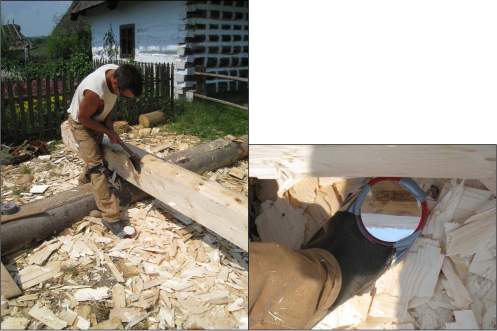
The first hewing setback was losing Kevin to a left hand injury. In spite of this, he remained productive, sharpening saws, carving handles to replace those broken. He could tell when my butt was draggin’ and had uplifting words. A big loss to the hewing effort, though. He’s a great carpenter and a good friend.
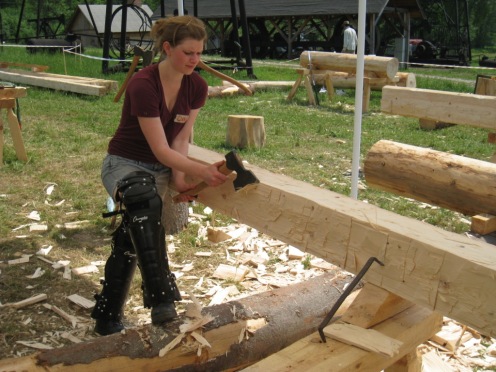
As our hewing skills developed, we had to learn to sustain the effort. A lot of that boiled down to nutrition. The hewers were constantly hungry and started hoarding food. The Dom would serve a generous buffet for breakfast. This was the only consistent opportunity to get the additional fuel needed for the strenuous work. I would make a sandwich and put it in the room to eat at bedtime. Get through the day? Fill a plastic bag with cut fruit. At first, I would eat at 10 o’clock and 2:30 to keep my blood sugar up. Then, it was a piece of fruit every hour. I had a food stash inside the leadership office, hidden with the rain gear. Although I ate constantly, I lost over ten pounds from the hard work over four weeks. Body by broadaxe.
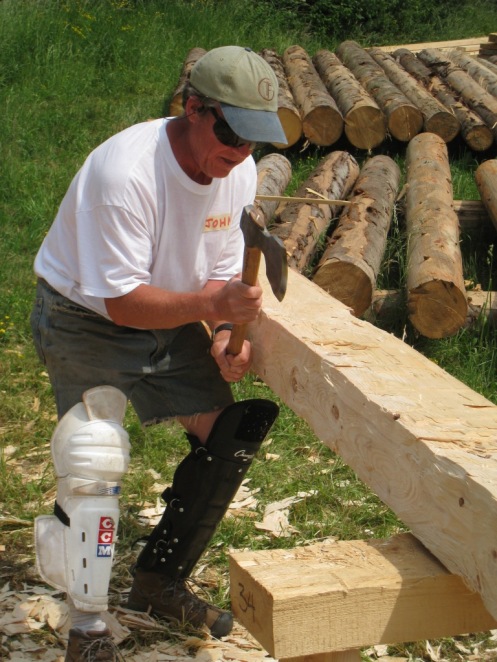
Dinners at the Dom were the same every night. A delicious soup, pork and potatoes. But the portions were modest. By the second week, a somewhat friendly competition developed for leftovers. Everyone knew that the big engines like Isaiah and Adam were hungry and needed the extra calories. So plates were passed around. I would always get to the dining table early so I could get a second bowl of soup.
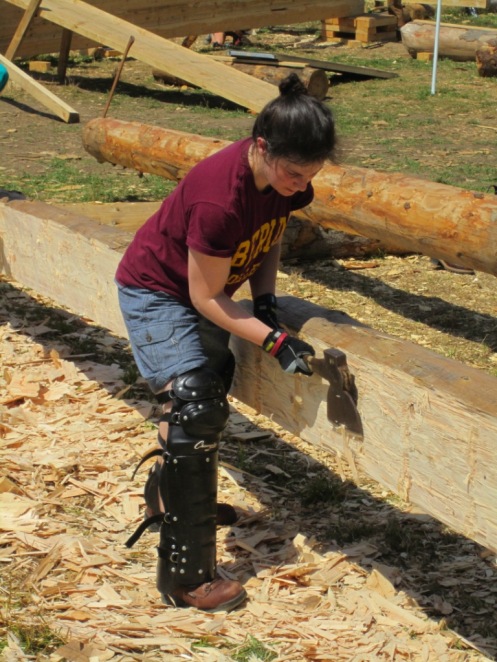
The days were regimented and long. Breakfast at 6:30. Around 7:30, the Hotel Dom crew would leave for the job site on foot or riding the cheesy rental bikes. Down the hill, over the bridge and through the Skansen. About 3 klicks. Such a beautiful place! Cuckoo, cuckoo (the bird, not the clock) echoing from the woods. Role call at 8:00, don’t be late! Summary from the team leaders about progress on the log wall, box frame, rafters and cupola. The safety briefing. Then passing the poetry hat. Work starts about 8:20. Lunch at twelve high. Bob Smith would ring the back-to-work bell at 12:30 and not a minute late. Quittin’ bell at 5. Put up the tools and head back across the San River. A Zywiec beer to cool off. Tom, did you see all the trout by the bridge? Dinner at 7. Dang, another 8 o’clock meeting? The only spare time to write postcards was early in the morning. The time zone in Poland is Greenwich Mean Time plus one; which is the same as the western coast of France. This far east, this far north means the sun comes up early. Light before 4 am.
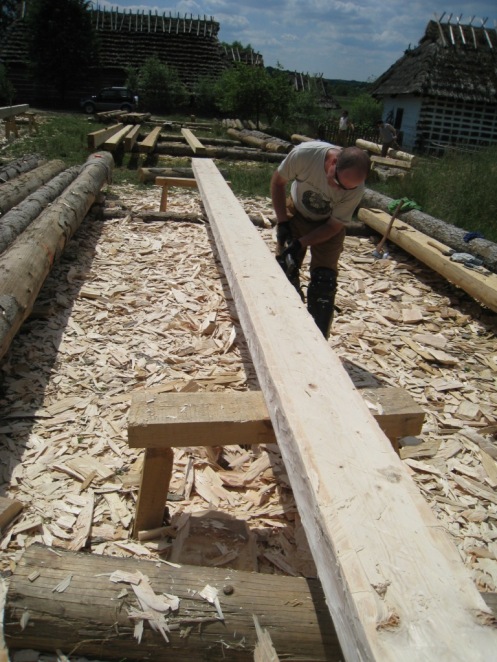
At some point, all Guild jobs turn. Hopefully sooner rather than later. It was well into the second week and we still weren’t producing timbers fast enough. For the Gwozdziec reconstruction hewing effort, this happened on Thursday afternoon, June 2. Mikkel got us together and read the Riot Act in a mild mannered Danish sort of way. By Saturday quitting time, the hewing effort had hit stride. Magically, the weather cooled. For the first week and a half, it had been hot. The two shade tents dedicated to hewing could accommodate only so many people swinging axes. Two sticks per tent. So much of the hewing was done out in full sun. The straw hat was my most important tool.
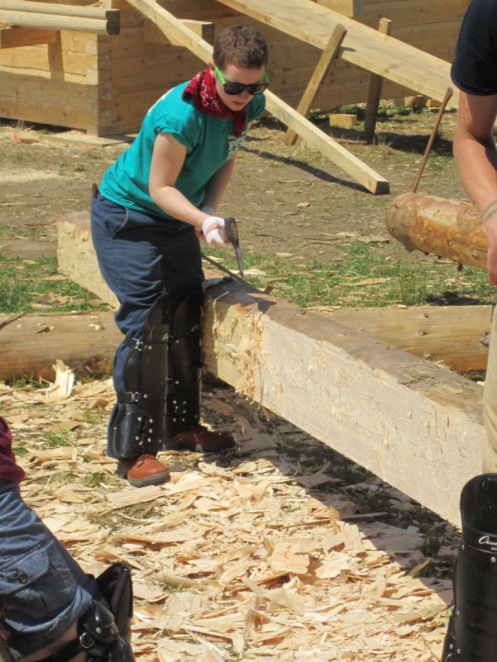
Alicia told us that by the end of the project, we’d have experience with different axes and develop preferences. I figured going into this endeavor, the single bevel broad axe with an offset handle was the obvious choice. After observing the beautiful scalloped timbers produced by Adam Z. many of us recognized the versatility of the double bevel, straight handled Gransfors model. We often encountered twisting grain or knots with diving grain. Hard to keep the line. Surface tear out. The double bevel axe could not only cleanly cut in both directions, but also produced an interesting grain pattern. Hewing from the top of the tree to bottom generally took care of grain challenges. Finish one side and then flip the stick with a cant hook to work the other. The few minutes spent re-establishing plumb was time well spent for the non-ambidextrous. We sharpened a lot.

Jacob, by contrast, produced beautiful, flat surfaces with his single bevel Danish broad axe. I saw Jacob plane a single, intact shaving the entire length of a twenty-five foot long log by wedging his body between the waste and timber as he progressed. By week three, Mikkel could look at a finished timber and make a pretty good guess who did the hewing by the finish and tool marks.
The importance of the deal Mikkel made with Gransfors Bruks for tools at reduced cost cannot be overestimated. Without the additional high quality felling and broad axes, we would have very likely fallen behind schedule without working additional hours and probably a Sunday or two. The felling axes did not rest. And Guild members got the deal of a lifetime. Thanks Mikkel for your foresight and kudos for your business savvy.
By week three, most of the hewers rotated into cutting joinery. Adam Z. and Jordan teamed up with Gerry David on the box frame. Mez, Bruce and Isaac scribed rafters with Bob Smith and Tim Whitehouse. Isaiah and David joined the log wall crew. Ellen cut curved pieces for the cupola with Jim. Barbara ran the pit saw. (Who’d I miss?) I took off a couple of days and went fishing. By week four, much of the remaining hewing was performed by students trained by our eloquent poet, Jackson. Emma Payne picked up the slack.
I write this story in front of a fan at the shack in Tulsa. A hundred and two in the shade. My walk away. The students deserve a lot of credit for the work accomplished. There were no significant injuries… count our blessings. Thanks to Rick and Laura for this incredible project and cool location. New friends. Relearning. The Guild delivers. A big part of the legacy. But mostly I remember the unrelenting demand to axe round to square.
Haanen
July 8, 2011
* * *
A day off. Tom briefly puts down his axe to pick up another tool:
Over the Guild’s twenty-five plus years, we have undertaken a steady flow of building projects, generally built in some kind of workshop format. Every few years we manage a truly major undertaking. The first of these came in 1989 with the building of two houses with Habitat for Humanity in Hanover, Pennsylvania. Timbers cut in shops all over North America and beyond came together to be raised into two house frames on a Thursday morning. Then the houses were finished in a round the clock marathon so the families could move in on Sunday. In 1992 hundreds of framers came together at a Guild Conference in Guelph, Ontario to build a 144 foot long covered bridge in five days. Almost a decade later in August and September of 2001, a group one tenth the size of the force at Guelph somehow managed to build almost twice the bridge (four trusses, two arches) with the help of the townspeople of Golden, British Columbia. Admittedly it took a little longer than five days. And there are other examples in our short history of timber framers coming together to build impossible dreams.
But perhaps none so audacious as the Gwozdziec Synagogue replica. Start with multiple courses of scribed log wall, a first in Guild building history. Surmount the log walls with an unusual timber frame roof for a total of 450 pieces and 16,000 board feet. Then add in a four stage compound curved cupola dovetailing perfectly inside the log walls and timber frame, with seven dozen curved ribs, including 20 backed hip/valley pieces, many of these to be hewn from natural curved sticks taken directly from the woods. Throw in 1500 square feet of cupola sheathing to be cut to form coves, domes and pendentives. Now recall that all the timber needs to have authentic hewn and pitsawn surfaces, and that all the joinery is to be done by hand.
I suspect you would agree that this mandate amounts to something like a miracle for a crew of thirty professionals working with a team of inexperienced students to accomplish in six weeks.
That said, now essentially double the work by deciding to convert all the timber directly from raw logs using spuds, drawknives, axes, broadaxes and pitsaws to turn 200 plus Silver Fir logs into those 450 timbers working entirely by hand in the traditional manner. The spreadsheets and the Gantt charts may have said it could be done, but even the stoutest of hearts had some doubts when first walking into that field in the Skansen carpeted with logs.
In tribute to the astonishing work of the hewers and sawyers, both professionals and students, we offer the following three posts:
Tom Haanen on Hewing
Barbara Czoch on Pitsawing
Sawyers at Work
* * *
Master hewer Petr Ruzicka and some of his tools:
A closeup of our frame saw:
And, by way of comparison, an open pitsaw at work:
* * *
A member of the Timber Framers Guild and an officer of our British cousin the Carpenter’s Fellowship, Barbara drove to the site in Sanok from her home in Hampshire, her car groaning under a load of tools piled to the brim. As a Polish speaker, she was frequently called on as a translator and to manage material and supply logistics. But most of us encountered Barbara around the saw trestle, usually working one end or the other of the pitsaw.
If we had four departments (log walls, box frame, roof frame & cupola), with a team leader for each, then, as the undisputed master of the pitsaw, Barbara was our minister without portfolio. She supplied the equipment (on loan from colleagues back in the UK), she maintained it, sharpened and set the saw, contributed to the design and construction of the saw trestle, directed the loading, shifting, swiveling and unloading of timber, schooled us in the use of the saw, and herself logged many, many hours as both top and under dog.
* * *
With some mix of relief and disbelief, I can report that the site pit saw has finally fallen silent – we are done! Outshot rafters, outshot hips, posts, collars, girts, cupola ties, outshot braces, down braces, X-braces, ridge braces, and struts are all finished.
I ought to point out that we are not in fact pit-sawing, you can tell by the distinct lack of any pit. We are swivel sawing on a trestle with a frame saw. What does that mean and why are we doing it anyway? Well, to turn a round log into a rectangular timber you hew it, but if you want to make it into smaller pieces you have to rip saw it as you can’t axe it down the middle. This is hard work, so to make it easier you put it on a high trestle and give 2 people the job – one up on the timber, the ‘top dog’ and one down below, the ‘under dog’ and then set them to arguing as to whose job is hardest! It’s called swivel sawing as first you saw from one end of the timber to the trestle, swivel the timber round and saw in from the other end till the kerfs meet up. This will leave you with a small triangle of un-sawn timber in the middle which you split apart when you take the timber down. This is a tell-tale sign of swivel sawing and the really cool part is that you can see these marks on the timbers in the museum buildings, so we know we are on the right track.
If there is one thing I have learnt about pit sawing it is that it’s definitely a team sport! Clearly it takes 2 people, but 3 or 4 is better so that you can switch over before you drop off the trestle in exhaustion! But firstly you need to find 2 people who will lend you their precious saws for 6 weeks, for which we are deeply indebted to Henry Russell and Steve Turner who probably should actually be here. Then next to Joe Thompson and our very own Leon Buckwalter who explained to me (patiently, several times) how to sharpen it, and then of course to the legions of ‘willing volunteers’ who came and pit sawed till they were pit sore! Too numerous to mention except for a few: Witek and David who machined their way through about 3/4 of what we cut in the first few weeks. They were averaging about 40 square feet of cut per day, which represents over 80 feet of run. We recorded their best effort to be a consistent 72 strokes per minute for over 12 feet in under 9 minutes, which compares well to a flutter wheel powered reciprocating saw mill which cuts 120 strokes per minute! But the women faired just as well: Kayla who is really quite small but has enthusiasm that seems to make her size irrelevant; Krista who is the opposite – extremely well built to the point of pushing the saw as well as pulling it and still being the last to get tired and swap out; and Ania who must be hiding some invisible muscles somewhere!
But I can guarantee that we will all be going home with more muscles than we came with, and I have been ceaselessly impressed by everyone’s grit and determination, and sheer hard work, and I for one am already missing that sweet, sweet sound of a freshly sharpened saw, swooshing its way along the snap line!
* * *
A few photos to supplement Barbara’s report:
Sharpening
Swiveling
The unsawn triangular patch
A pitsaw shaving. Note the chalk line down the center of the shaving.
There are somewhere between four and five thousand photos currently in the archive for the Gwozdziec Re!konstrukcja Blog. Of these a couple of hundred show sawyers at work. What follows is a representative selection. Over our six weeks at work in Sanok, pretty much everyone took a turn at sawing, some briefly, some steadily.
Having tried a variety of compilations of pitsaw pictures, I note one interesting fact: No matter how you cut and shuffle the deck, Barbara seems to always appear in a third of the pictures, tirelessly sawing away. Check it out for yourself.
Here to honor their achievement is a small sample of those sawyers at work.
Captions below refer to the pictures above them. A couple of the sawyers are unidentified. If you know who they are, please let us know (also if any are misidentified).
Ted\Barbara, ????\Justus
Kayla below, Kayla above
Andy\Barbara, Rob exhibiting the power of concentration
Daughter Emma\ Father Tom, Jan\Barbara
Sculptor Marian Zub\Emma channeling Paul Pierce, Marcin showing the latest in pitsaw fashion
Barbara/Ted, Miah\Justus
????\Adam V., Emma/
/Barbara, Tom\Barbara
Anna\Kayla, Barbara\Adam V.
Kayla\Barbara, Rob\Mark Olson
Jordan\Mark Olson, Rob\Andrew
Kayla\Barbara, Justus, Krista
Krista\Barbara, Krista\Emma
Adam V./Nick, Clement/Tom
Barbara\Kayla, Anna\Kayla
Rob\Mark Olson, ????\Rob
Mark Oteri\Alicia, Anna\Rob
Clement/Tom, Rob\Jordan
The bulk of the Gwozdziec builders are scattering far and wide, most back to their lives and families, some to further travels and a few will move right on to the first painting workshop in Rzeszow. So the news of the synagogue timber frame build is over, or at least on long hiatus until the next phase later this year.
But there are a few untold stories yet to find their way up on the blog, along with some feature items that have been patiently waiting in line.
So, subject to reader interest and Guild management approval, I would like to carry on for a few more days. This note is coming to you from Toronto Aiport, two flights into a three flight trip from Rzeszow to Philadelphia, and the first spot I’ve found a signal on which to upload to the blog.
This will be it for today, but, subject to jet lag and family plans, look for more synagogue stories over the weekend. And if any of the returning or traveling team members would like to use their new free time to write something and send it this way, that would be much appreciated.
Time to get on the plane. Talk with you soon.
